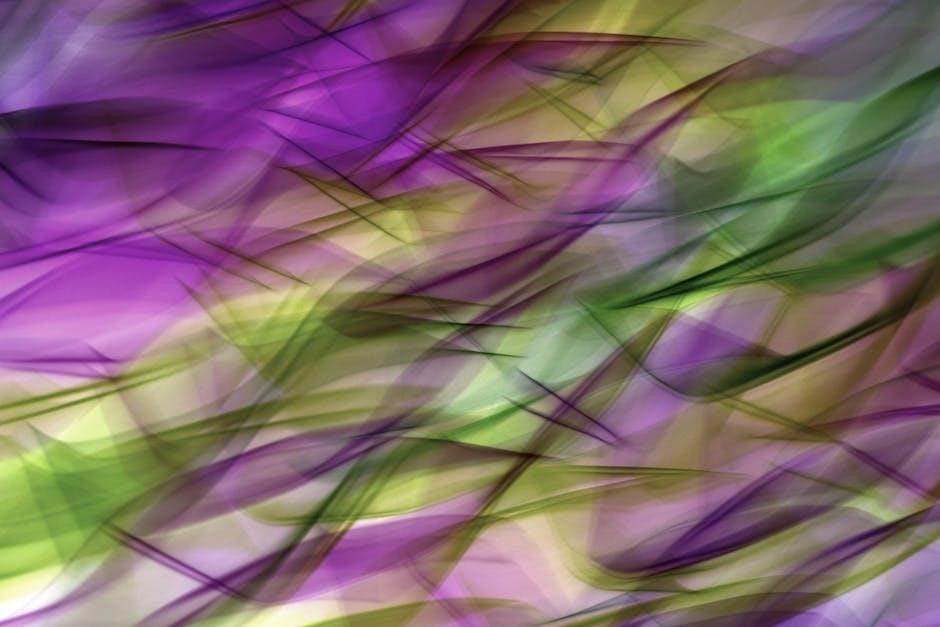
mouth blend shape guide
Mouth blend shapes are essential for creating realistic facial animations, enabling precise lip and mouth movements. This guide explores their fundamentals, applications, and techniques for seamless integration in 3D character design and animation workflows.
Key Concepts and Terminology
Blendshapes are essential for facial animations, involving mouth anatomy and precise movements. Terminology like ‘blendshapes’ and ‘mouth anatomy’ is crucial for understanding and applying these concepts effectively in character design and animation.

2.1. Understanding Blendshapes
Blendshapes are foundational for creating realistic facial animations, particularly for the mouth. They involve predefined deformations that morph the mouth’s shape to match specific expressions or movements. These deformations are controlled by sliders or parameters, allowing animators to achieve precise and nuanced expressions. Blendshapes are essential for syncing lip movements with audio, ensuring realistic speech animations. They are also used to create complex expressions, from subtle emotive cues to exaggerated animations. Understanding blendshapes is crucial for designing realistic mouth movements in 3D characters, enabling seamless integration into various applications like virtual YouTubers, video games, and films. Properly crafted blendshapes enhance the believability of animations, making characters more engaging and lifelike. Tools like Blender and VSeeFace simplify the creation and tracking of these shapes, making them accessible to both novice and experienced animators. This section delves into the core concepts of blendshapes, their functionality, and their role in modern animation workflows.

2.2. Mouth Anatomy for Blendshapes
Mouth anatomy plays a crucial role in creating realistic blendshapes, as it directly influences how expressions and movements are animated. The mouth’s structure, including muscles like the orbicularis oris and zygomaticus, determines its flexibility and range of motion. Understanding these anatomical elements helps in designing accurate blendshapes that mimic real-life expressions. For instance, the orbicularis oris controls lip puckering and closure, while the zygomaticus muscles are responsible for smiling. Accurately capturing these movements ensures believable animations. Tools like VSeeFace and Blender allow for precise tracking and replication of these anatomical behaviors, enabling animators to create lifelike mouth animations. By studying mouth anatomy, creators can craft blendshapes that align with natural human expressions, enhancing the realism and emotional impact of their characters. This foundation is vital for achieving seamless integration of blendshapes in various applications, from films to virtual avatars.
2.3. Importance in Facial Animation
Mouth blendshapes are fundamental to creating realistic and engaging facial animations, as they capture the subtleties of human expressions and emotions. Accurate mouth movements convey speech, emotions, and character intent, making them indispensable in animation. Blendshapes enable precise control over lip, tongue, and jaw movements, ensuring synchronized audio-visual experiences. This technology is vital for virtual avatars, films, and video games, where believable character interactions are key. By replicating natural mouth anatomy and muscle behavior, blendshapes enhance the emotional depth and relatability of animated characters. Their importance lies in their ability to bridge the gap between static models and lifelike performances, ensuring seamless communication of emotions and narratives. As such, mastering mouth blendshapes is essential for achieving high-quality facial animation in various creative industries.

Tools and Software for Creating Mouth Blendshapes
Blender, Maya, and VSeeFace are popular tools for creating mouth blendshapes, offering robust features for 3D modeling, animation, and real-time tracking to design precise facial expressions and movements.
3.1. Blender for Blendshape Creation

Blender is a free, open-source 3D software widely used for creating blendshapes due to its flexibility and powerful tools. It offers a robust shape key system, allowing artists to design and animate complex mouth movements. By utilizing Blender’s modifiers and rigging tools, users can create realistic deformations and smooth transitions between shapes. The software’s customizable interface and extensive Python scripting capabilities make it ideal for streamlining the blendshape creation process. Additionally, Blender supports the export of blendshapes to various formats, ensuring compatibility with other applications. Its active community and extensive tutorials provide ample resources for artists to master blendshape creation, making it a preferred choice for both beginners and professionals in the field of facial animation and character design;
3.2. Maya and Other 3D Software
Maya, a professional 3D animation tool, excels in blendshape creation with its advanced Blendshape Editor and Deformer system; Artists can craft intricate mouth animations by adjusting weights and targets, ensuring smooth transitions. The software’s scripting capabilities enable automation and customization of blendshape workflows. Other tools like 3ds Max and Cinema 4D also offer robust blendshape systems, though Maya remains the industry standard. These programs provide precise control over facial anatomy, allowing for realistic expressions. For optimal results, artists often pair Maya with other tools like VSeeFace for real-time tracking. By leveraging these software options, creators can achieve high-quality mouth animations tailored to their projects’ needs, ensuring lifelike character performances.

3.3. VSeeFace and Other Tracking Tools
VSeeFace is a popular tool for real-time face and hand tracking, widely used by virtual YouTubers and streamers. It enables precise puppeteering of avatars, allowing for dynamic mouth and facial animations. The software supports customizable blendshapes, making it ideal for syncing mouth movements with audio. Other tracking tools, like Faceware and Live2D, offer similar functionalities, catering to different workflows and preferences. These tools are essential for creating engaging real-time animations, particularly in virtual productions and live streams. By integrating with 3D software, they bridge the gap between tracking data and blendshape animations, ensuring seamless character expressions. Whether for virtual avatars or real-time performances, these tools are indispensable in modern animation workflows.

Techniques for Designing Mouth Blendshapes
Mastering mouth blendshape design involves creating basic shapes, syncing movements with audio, and handling complex expressions. Tools like Blender and VSeeFace aid in precise animations, ensuring realistic character interactions.
4.1. Creating Basic Blendshapes
To create basic mouth blendshapes, start by identifying essential expressions like neutral, open, smile, and frown. Use 3D modeling tools such as Blender to sculpt each shape, ensuring they represent natural mouth movements. Focus on anatomical accuracy, capturing how muscles move the mouth. Begin with the neutral pose, then develop each blendshape to be distinct yet adaptable for mixing. Keep the number of shapes minimal for efficiency, especially in real-time applications. Test each blendshape to ensure smooth transitions and realistic appearances. By systematically crafting these foundational shapes, you establish a versatile framework for facial animations.
4.2. Syncing Mouth Movements with Audio
Syncing mouth movements with audio is crucial for creating realistic animations, particularly in character design and storytelling. This process involves aligning the character’s mouth blendshapes with the audio dialogue to ensure lip-sync accuracy. Tools like Blender and Maya are commonly used for this purpose, allowing precise control over mouth movements. The process typically starts by importing the audio into the animation software and analyzing the waveform or phonemes to determine the appropriate mouth shapes. By assigning specific blendshapes to match the audio cues, animators can achieve a natural and believable synchronization. Timing and precision are key to ensuring the movements appear realistic and engaging. Testing and refining the synchronization is essential, as even slight misalignments can distract from the overall animation quality. This step is vital for applications like virtual YouTubers, film animations, and video games, where realistic lip-sync enhances the audience’s immersion and engagement.
4.3. Handling Complex Expressions
Handling complex expressions requires a deep understanding of both anatomy and animation principles. When designing mouth blendshapes, it’s important to capture subtle movements that convey emotions effectively. For instance, a slight smile can differ from a wide grin in terms of muscle engagement and shape. To achieve this, animators often create a library of blendshapes that can be combined to produce a wide range of expressions. Tools like Blender and Maya allow for the creation of detailed blendshape systems, enabling precise control over facial movements. Additionally, techniques such as layering expressions and using corrective shapes can help maintain realistic deformations. Testing these expressions in real-time and refining them based on feedback ensures that the final result looks natural and believable. This attention to detail is crucial for applications like virtual avatars, film, and video games, where complex expressions enhance character authenticity and audience connection.

Best Practices for Effective Mouth Blendshapes
Customize blendshapes for character uniqueness, test expressions in real-time, and refine based on feedback. Optimize for performance to ensure smooth animations, enhancing realism and audience engagement in dynamic applications.
5.1. Customizing for Different Characters
Customizing mouth blendshapes for different characters ensures unique and expressive animations. Using tools like VSeeFace and Blender, artists can tailor mouth movements to fit specific characters’ traits, such as face shape or personality. For instance, a youthful character might require softer, more rounded expressions, while a dramatic character could benefit from exaggerated movements. Understanding the character’s anatomy and emotional range is key to creating authentic animations. Proportion and symmetry must be balanced to avoid unnatural results. Testing expressions in real-time and refining based on feedback helps achieve desired outcomes. This process ensures each character’s identity shines through their animations, making them relatable and engaging. Regular optimization ensures smooth performance, especially in real-time applications like virtual YouTubers or VR avatars.
5.2. Testing and Refining Blendshapes
Testing and refining blendshapes is a critical phase in ensuring realistic and engaging animations. Begin by previewing the blendshapes in real-time using tools like VSeeFace or Blender to observe how they perform. Pay attention to the accuracy of mouth movements, ensuring they align with audio and emotional expressions. Identify any anomalies, such as exaggerated or unnatural movements, and refine the shapes accordingly. Iterative feedback loops with animators or directors can help pinpoint areas needing adjustment. Additionally, test across different characters to ensure compatibility and consistency. Optimization involves minimizing data usage while maintaining quality, ensuring smooth performance in real-time applications. Regular refinement guarantees that the final product meets the desired aesthetic and functional standards for immersive storytelling and character interaction.
5.3. Optimization for Real-Time Use
Optimizing mouth blendshapes for real-time use involves balancing performance and quality. Begin by reducing the complexity of blendshapes while maintaining expressive accuracy. Simplify bone structures and ensure smooth transitions between shapes. Use tools like VSeeFace to test real-time tracking, adjusting weights and limits for natural movement. Minimize data usage by focusing on essential expressions, ensuring compatibility with various platforms. Regularly review and refine animations to eliminate jitter or lag. Implement automated optimization scripts where possible to streamline workflows. Finally, ensure consistency across different characters and scenarios, maintaining visual fidelity while prioritizing performance. This balance ensures seamless integration into real-time applications like virtual avatars or video games, enhancing user experience without compromising artistic intent.

Applications of Mouth Blendshapes
Mouth blendshapes are widely used in virtual YouTubers, VR avatars, film, and video game animations. They enhance realistic facial expressions, enabling lifelike interactions in robotics, real-time streaming, and puppeteering applications, ensuring dynamic visual storytelling.
6.1. Virtual YouTubers and VR Avatars
Mouth blendshapes are crucial for creating lifelike animations in virtual YouTubers (VTubers) and VR avatars. These animations require precise lip movements and facial expressions to convey emotions convincingly. Tools like VSeeFace enable real-time tracking of facial movements, translating them into digital avatars seamlessly. This technology allows VTubers to engage audiences with dynamic, expressive performances, making their content more immersive and relatable. For VR avatars, blendshapes ensure smooth transitions between expressions, enhancing user interactions in virtual environments. Customizing mouth blendshapes for different characters or personas is key, enabling unique identities and styles. Whether for entertainment, education, or social interactions, mouth blendshapes are essential for delivering authentic and engaging virtual experiences. Their versatility and realism make them indispensable in the growing world of digital avatars and virtual entertainment.

6.2. Film and Video Game Animations
Mouth blendshapes are pivotal in film and video game animations for creating realistic character expressions. In films, they enable precise control over lip movements and facial nuances, enhancing emotional depth. For video games, blendshapes ensure smooth, believable animations during dialogue and cutscenes. Designers often create a foundation of basic shapes, which are then refined and synced with audio for lifelike speech. Tools like Maya and Blender streamline this process, allowing artists to craft detailed animations efficiently. The integration of blendshapes with procedural systems further enhances realism, enabling dynamic reactions. As technology advances, the demand for high-quality mouth animations in entertainment media continues to grow, making blendshapes an indispensable tool for animators and game developers aiming to captivate audiences with immersive stories and characters.
6.3. Robotics and AI Applications
Mouth blendshapes play a crucial role in robotics and AI, particularly in creating realistic facial expressions for humanoid robots and AI-driven characters. These blendshapes enable precise lip movements and emotional expressions, making interactions feel more natural. In robotics, blendshapes are used to simulate human-like speech patterns, enhancing communication between humans and machines. AI applications leverage blendshapes to generate realistic animations for virtual assistants and chatbots, ensuring seamless user interaction. Tools like VSeeFace facilitate real-time tracking and animation, allowing for dynamic facial expressions in AI characters. By integrating blendshapes, developers can create more engaging and lifelike interfaces, fostering trust and connection with users. This technology continues to advance, promising even more sophisticated applications in the future, where robots and AI systems can convey emotions as effectively as humans.
6.4. Real-Time Streaming and Puppeteering
Real-time streaming and puppeteering rely heavily on mouth blendshapes to bring characters to life instantly. Tools like VSeeFace enable live facial tracking, translating an actor’s expressions into a digital avatar. This technology is widely used by virtual YouTubers and streamers to create engaging, interactive content. Puppeteering allows for precise control over mouth movements, syncing them seamlessly with audio for realistic dialogue delivery. Blendshapes are crucial for capturing subtle lip and jaw movements, ensuring animations appear natural. Real-time systems often optimize blendshapes for performance, balancing detail with efficiency. This technique is particularly valuable in live performances, where delays or lag must be avoided. By integrating mouth blendshapes, creators can achieve immersive, real-time character animations, fostering deeper audience connections. This application highlights the versatility of blendshapes in modern digital entertainment and communication.
Mouth blendshapes are foundational for realistic facial animations, evolving with advancements in AI and real-time tracking. Future trends include enhanced expressiveness and seamless integration across VR, film, and robotics.
7.1. The Evolution of Blendshape Technology
Blendshape technology has significantly advanced, transitioning from basic 2D systems to sophisticated 3D models. Early implementations relied on limited control points, while modern tools like Blender and VSeeFace offer precise manipulation. The integration of AI and machine learning has enabled real-time tracking and dynamic adjustments, enhancing realism in animations. Virtual YouTubers and VR avatars benefit from these advancements, achieving lifelike expressions. As technology progresses, blendshapes are becoming more accessible, empowering creators to craft compelling characters efficiently.
7.2. Trends in Facial Animation
Facial animation is advancing rapidly, driven by demand for realism in virtual characters. Current trends emphasize real-time tracking tools like VSeeFace, enabling dynamic expressions. AI integration enhances precision, allowing for nuanced mouth movements; Personalized avatars, popular among VR and streaming communities, rely on blendshapes for authenticity. The shift toward accessible software democratizes animation, empowering indie creators. Collaborative platforms foster innovation, blending artistic and technical expertise. As technology evolves, facial animation becomes more immersive, pushing boundaries in storytelling and virtual interactions.